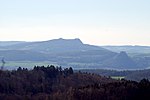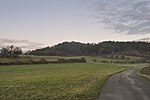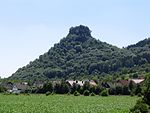Hegau
Freiburg region geography stubsHegauNatural regions of the Alpine ForelandRegional geology stubsRegions of Baden-Württemberg

The Hegau is an extinct volcanic landscape in southern Germany extending around the industrial city of Singen (Hohentwiel), between Lake Constance in the east, the Rhine River in the south, the Danube River in the north and the Randen—as the southwestern mountains of the Swabian Jura are called—in the west. It was first mentioned in A.D. 787 in the Latinised form in pago Egauinsse. The most famous sight of the Hegau is the Hohentwiel, a volcanic stub. On top of the mountain lies the Hohentwiel fortress. The Hohentwiel is the southernmost of a row of volcanic stubs in the Hegau, including the Hohenkrähen, the Hohenstoffeln, and the Hohenhewen.
Excerpt from the Wikipedia article Hegau (License: CC BY-SA 3.0, Authors, Images).Hegau
Basaltwerk,
Geographical coordinates (GPS) Address Nearby Places Show on map
Geographical coordinates (GPS)
| Latitude | Longitude |
|---|---|
| N 47.7964 ° | E 8.75 ° |
Address
Hohenstoffeln
Basaltwerk
78247
Baden-Württemberg, Germany
Open on Google Maps











